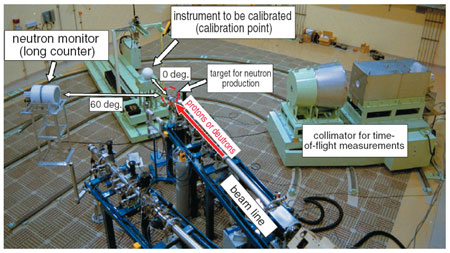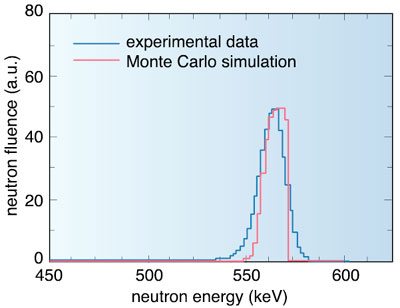It is difficult to measure the neutron dose equivalent properly because the sensitivity of a neutron dosimeter depends greatly on the energy of the neutrons. To improve the accuracy of the measurement, it is important to determine precisely the energy response of the dosimeter. Therefore, calibration fields with various neutron energies are necessary for such a determination.
To meet this need, we developed monoenergetic neutron calibration fields (Fig. 3-6) using a charged particle accelerator. The charged particles (protons or deuterons) are accelerated and bombard the target, which then produces neutrons from the resulting nuclear reactions. The monoenergetic neutrons generated by these reactions provide these calibration fields.
Fields of 144 keV, 565 keV, and 5.0 MeV have presently been developed using 7Li(p,n)7Be and 2H(d,n)3He reactions. The energies of the neutrons are determined by the precise measurement of neutron flight times with a liquid scintillation detector. The energy spreads are narrow enough to calibrate the neutron dosimeters (Fig. 3-7 and Table 3-1).
The reference neutron fluence at the calibration point is determined from the count of a neutron monitor located in the irradiation room. A conversion coefficient from the count of the monitor to the neutron fluence was evaluated using a neutron detector (the transfer instrument) whose sensitivity was determined at the primary standard laboratory, National Institute of Advanced Industrial Science and Technology (AIST). The traceability to AIST of the neutron fluence was established by this procedure. Using this process, the fields were constructed as secondary standard fields and it is possible to estimate the precise characteristics of neutron dosimeters.
In the future, the available energy range will be expanded from 8 keV to 20 MeV by using other nuclear reactions and adjusting the terminal voltage of the accelerator.
|


